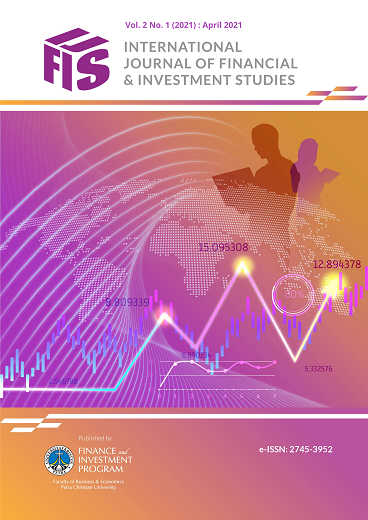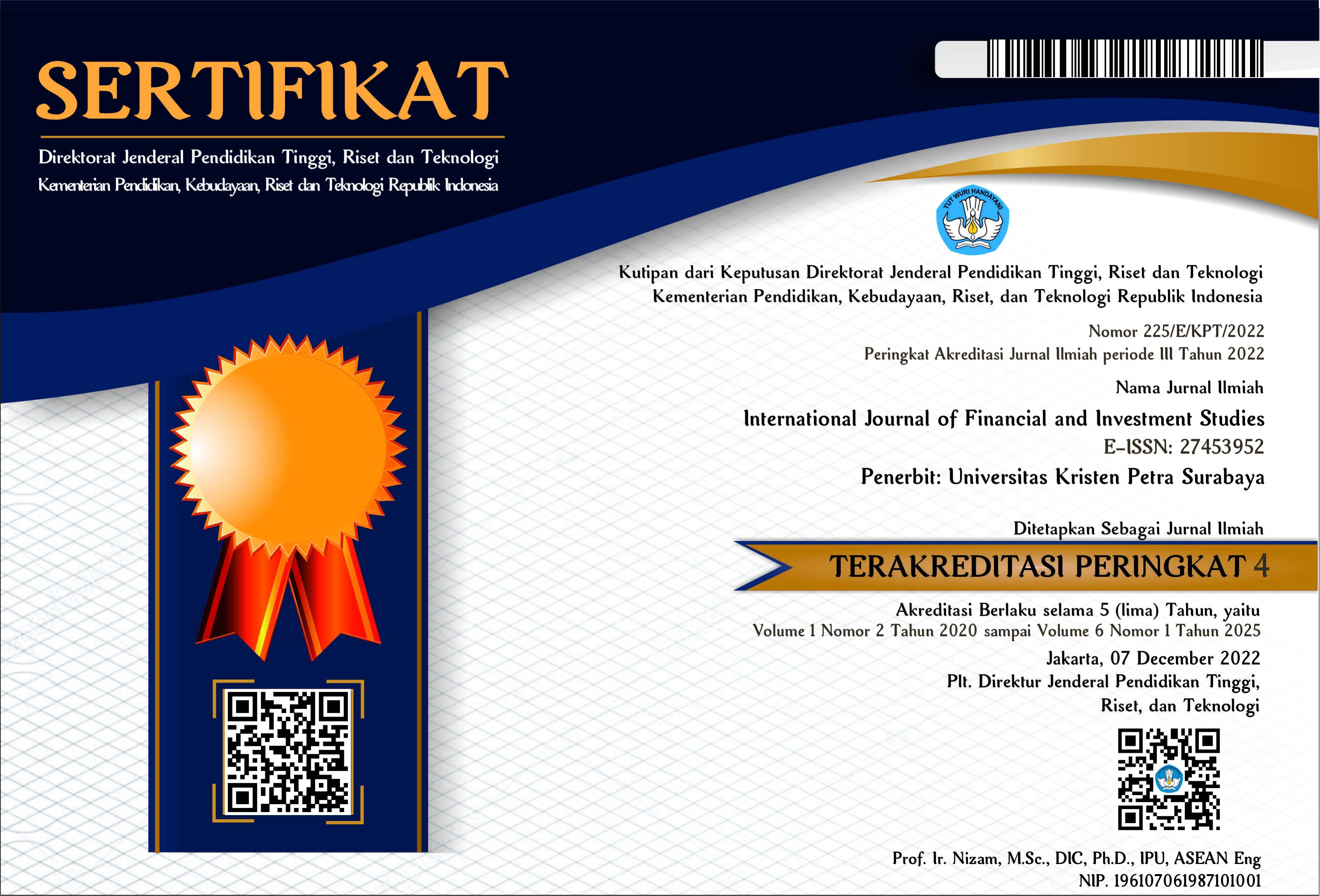RISK AVERSION AND OVERCONFIDENCE IN GENDER PERSPECTIVE
Abstract
This study analyzes the relationship between gender and risk aversion and overconfidence in making financial asset investment decisions for investors in Surabaya. The sample in this study amounted to 179 investors. Data were collected using a questionnaire. Methods of data analysis were performed using cross-tabulations and chi-square. This analysis shows that gender has a significant relationship with risk aversion and overconfidence in making financial asset investment decisions.
Downloads
References
Ariadi, 2015. Analysis of The Relationship Between Financial Literacy and Demography with Investment, Saving and Consumption. Journal of Finsta, Volume 3 No. 1. Pg. 7-12.
Baker, H., & Ricciardi, V. (2014). Investor Behavior: The Psychology of Financial Planning and Investing (Kolb Series). United State: John Wiley & Sons, Inc.
Barber B. and Odean, T. (2001), “Boys Will Be Boys: Gender Overconfidence and Common Stock Investment “, Working Paper, University of California at Davis.
Bhandari, G., & Deaves, R. (2006). The Demographics of Overconfidence. Journal of Behavioral Finance, 7(1), 5-11. doi: 10.1207/s15427579jpfm0701_2
Bodie, Z., Kane, A., & Markus, A. (2018). Investment. Eleventh Edition. North America: McGraw-Hill.
De Bortoli D, da Costa N Jr, Goulart M, Campara J (2019). Personality Traits and Investor Profile Analysis: A Behavioral Finance Study. Romania: The Bucharest University of Economic Studies.
Grable, J., Lytton, R H. (1999). “Financial Risk Tolerance Revisited: The Development of A Risk Assessment Instrument.” Financial Services Review 8 (1999) 163-181.
Graham, J., Stendardi, E., Myers, J., & Graham, M. (2002). “Gender Differences in Investment Strategies: An Information Processing Perspective.” International Journal of Bank Marketing, 20(1), 17-26. doi: 10.1108/ 02652320210415953
Gunawan, MF (2015). Pengaruh Risk Tolerance dan Personality Tratis Terhadap Pemilihan Portofolio Investor di Surabaya. Universitas Kristen Petra. Surabaya.
Hungu. (2007). Demografi Kesehatan Indonesia. Jakarta: Penebit Grasindo.
Kahneman, D., dan Tversky, A. 1972. Subjective probability: A Judgment of Representativeness. Cognitive Psychology, 3, 430-454.
Koerniawan, S. A., and Malelak, M. I. (2021). The Influence of Female Director on The Probability of Companies Experiencing Financial Distress. International Journal of Financial and Investment Studies (IJFIS), 1(2), 101-108. Retrieved from https://ojs.petra.ac.id/ijfis/index.php/ijfis/article/view/59.
Kurniawan, J. Y., Malelak, M. I., and Astuti, D. (2020). Pengaruh Attitude, Subjective Norm, Past Behavior, dan Perceived Control Terhadap Budgeting Intention Mahasiswa di Surabaya. International Journal of Financial and Investment Studies (IJFIS), 1(1), 21-29. https://doi.org/10.9744/ijfis.1.1.21-29.
Lemenshow, S., Hosmer., Klar, J., & Lwanga, S. (1990). Adequacy of Sample Size in Health Studies. England: John Wiley & Sons Ltd.
Lewellen, W., Lease, R., & Schlarbaum, G. (1977). Patterns of Investment Strategy and Behavior Among Individual Investors. The Journal of Business. 50. 296-333. 10.1086/295947.
Markowitz, HM (1952) “Portfolio Selection” The Journal of Finance: XXI pages 77-91
Nasarudin, MI, & Surya, I. (2004). Aspek Hukum Pasar Modal Indonesia. Jakarta: Prenada Media.
Nofsinger, John R. (2005). Psychologi of Investing. Second Edition. New Jersey. Precentice-Hall inc.
Pompian, Michael M. (2012); Behavioral Finance and Investor Types: Managing Behavior to Make Better Investment Decisions; John Wiley & Sons.
Santosa, S. (2015) Menguasai SPSS 22. Jakarta: PT. Elex Media Komputindo.
Saputra, Herwono Indra. (2013). Jenis Investasi Berdasarkan Profil Risiko. FINESTA Vol. 1, No. 2, (2013) 47-52
Schubert, R., Brown, M., Gysler, M., & Brachinger, H. (1999). Financial Decision-Making: Are Women Really More Risk Averse? American Economic Review, 89(2), 381-385.
Sugiyono. (2010). Metode Penelitian Kuantitatif, Kualitatif, dan R & D. Bandung: Alfabeta.
Tandelilin, E. 2001. Portofolio dan Investasi. Edisi Pertama. Yogyakarta: Kanisius.
Thaler, RH 1994. Psychology dan Saving Policies. American Economic Review, Vol. 84, No. 2, pp. 186-192.
Widjaja, R. and Pertiwi, D. (2021). The Influence of Emotional Factors, Materialism, Risk Perception, and Financial Literacy on The Tendency of Debt of Millennial Generation in Surabaya. International Journal of Financial and Investment Studies (IJFIS), 1(2), 85-93. Retrieved from https://ojs.petra.ac.id/ijfis/index.php/ijfis/article/view/57
Authors who publish in this journal agree to the following terms:
- Authors retain unrestricted copyright and full publishing rights. The authors grant the Publisher the right of first publication, with the work simultaneously licensed under the terms and conditions of the Creative Commons Attribution 4.0 International License.
- Authors can enter into separate, additional contractual arrangements for the non-exclusive distribution of the journal's published version of the work (e.g., post it to an institutional repository or publish it in a book), with an acknowledgment of its initial publication in this journal.
- Authors are permitted and encouraged to post their work online (e.g., in institutional repositories or on their website) before and during the submission process, as it can lead to productive exchanges and earlier and more extraordinary citations of published work.















